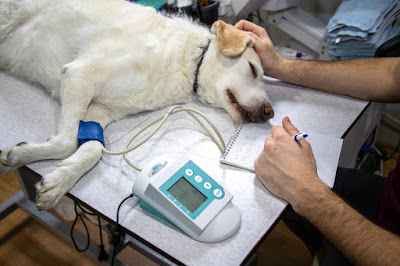Cushing's Disease in Dogs
Cushing's Disease in Dogs
What Is Cushing's Disease in Dogs?
The endocrine system is the collective machine of glands that produce and secrete hormones in the body, certainly one of which is the hormone cortisol. At normal levels, cortisol performs many beneficial functions, which includes assisting people to reply to stress and modulating the immune device, but an excessive amount of cortisol inside the body can do a variety of damage.
The situation related to extra cortisol is medically known as hyperadrenocorticism or Cushing’s sickness, and it's miles one of the maximum commonplace endocrine issues that have an effect on puppies.
Cushing’s disease in dogs develops whilst their very own frame overproduces cortisol. Hyperadrenocorticism in dogs generally impacts middle-aged to older animals. At any age, taking high levels of steroid canine medications or taking those medicinal drugs for a long time can motive the identical signs.
Symptoms of Cushing's Disease in Dogs
Keep in thoughts that each one symptom isn't apparent in each affected person and that some of the signs can also be related to different diseases.
To determine whether or not or now not a canine has Cushing’s disease, a veterinarian will want to look no longer just at a canine’s signs and symptoms, however also at the consequences of numerous one of a kind diagnostic exams.
Here are some commonplace signs and symptoms associated with Cushing’s disease in puppies:
Increased thirst and urination (polydipsia and polyuria, respectively)
Urinating at night time or having injuries
Increased hunger
Increased panting
Pot-bellied stomach
Obesity
Fat pads at the neck and shoulders
Loss of hair
Lack of electricity
Muscle weak point
Infertility
Darkening of the skin
Thin skin
Bruising
Hard, white scaly patches on the pores and skin, elbows, and so forth. (related to the sickness calcinosis cutis)
What Causes Cushing's Disease in Dogs?
hyperadrenocorticism in dogs
The maximum not unusual motive of hyperadrenocorticism in dogs is a benign (non-spreading) pituitary tumor. Rarely, pituitary tumors may be malignant.
When a canine’s Cushing’s disease develops because of troubles within the pituitary gland, the situation is referred to as pituitary-based hyperadrenocorticism (PDH). PDH is responsible for about 80 to 85 percent of cases of clearly occurring hyperadrenocorticism in puppies.
cushing disease dog behavior
adrenal gland in dogs
Tumors within the adrenal gland in dogs(adrenal-established hyperadrenocorticism or ADH) are accountable for the alternative 15 to twenty percent of cases of obviously going on Cushing’s sickness in dogs. Adrenal tumors have about an equal chance of being benign or malignant.
Excessive (excessive-dose or lengthy-time period) management of corticosteroid medicinal drugs also can motive hyperadrenocorticism in puppies. These drugs are normally used to deal with allergic reactions, immune problems, and a few sorts of most cancers; to reduce infection; or as replacement remedy for low, evidently occurring cortisone stages. Iatrogenic Cushing’s disease is reversible with the aid of preventing or lowering medicine.
Diagnosis
To diagnose Cushing’s sickness in puppies, your veterinarian will first take a complete health record of your dog after which carry out a whole bodily examination. Basic lab paintings like a blood chemistry profile, complete blood cellular remember, fecal examination, and a urinalysis will possibly comply with.
If primarily based on this initial assessment, your veterinarian suspects that Cushing’s ailment is a probable motive of your canine’s signs and symptoms, he or she will be able to then run the checks which can be necessary to definitively diagnose the condition.
The first check is regularly urine cortisol: creatinine ratio. If the take a look at results are ordinary, then your canine probable does no longer have Cushing’s disorder. If your dog has high urine cortisol: creatinine ratio, then, also, trying out is referred to as for, given that many conditions can lead to this end result.
The maximum commonplace test used to diagnose Cushing’s sickness in dogs is the low-dose dexamethasone suppression test (LDDST). A blood sample is taken to degree a canine’s baseline cortisol level, and then a small quantity of dexamethasone is administered by injection. Blood cortisol stages are measured 4 and eight hours after the dexamethasone is given.
In an everyday dog, the dexamethasone injection inhibits the secretion of a hormone that stimulates cortisol secretion, which leads to a decrease in circulating cortisol stages. In a canine with Cushing’s sickness, cortisol is not suppressed.
Unfortunately, no one diagnostic check is definitive for Cushing’s disorder in all cases. Veterinarians may additionally want to additionally run an ACTH stimulation test and/or perform a belly ultrasound to determine whether or not or not a canine has Cushing’s, and in that case, whether or not PDH or ADH is guilty. Abdominal ultrasound and chest X-rays can also be beneficial in determining if the tumor has spread and is malignant.
Treatment for Cushing's Disease in Dogs
Treatment for Cushing’s disease that develops because of corticosteroid medication overuse is reasonably trustworthy. Dogs must be slowly weaned off of those medications even as below a veterinarian’s care. Removing these medications too speedy can lead to an existence-threatening condition called an Addisonian disaster.
Dogs with moderate signs and symptoms associated with pituitary-structured Cushing’s disease may not want instantaneous treatment but must be intently monitored to decide when it might be beneficial. In well-known, the remedy ought to start whilst a dog develops symptoms that are potentially dangerous and/or troublesome to the pet or proprietor.
These might encompass excessive blood pressure, and accelerated urine protein: creatinine ratio (proof of kidney harm), recurrent infections, urinary accidents, having to rise up in the nighttime to urinate, exercising intolerance, and immoderate panting.
Once the decision to treat a canine’s pituitary-based Cushing’s disease has been reached, a veterinarian will probably prescribe trilostane (Vetoryl). This drug may have critical facet results, so puppies taking it ought to be intently monitored. Trilostane may additionally have interaction with different common canine medications, so it is essential to discuss all medicinal drugs and supplements along with your veterinarian.
When a patient is identified with an adrenal tumor, chest radiographs, and likely a CT scan or MRI ought to be taken to study the frame for any viable metastatic unfold of the disease. If no metastases are seen, the dog is regularly given a remedy (trilostane) for some months to decrease the tumor, accompanied through a surgical procedure to dispose of it.
Living with and Managing Cushing's Disease
If your dog is being handled with trilostane for Cushing’s ailment, you need to be prepared to preserve remedy for the life of your puppy. You will want to be observant of any destructive reactions to these powerful medicines.
Typical signs of an adverse reaction are lack of electricity, weakness, lack of urge for food, vomiting, diarrhea, and once in awhile difficulty taking walks. If any of these facet-consequences do arise, you need to contact your veterinarian straight away and discontinue remedy beneath their supervision.
Because of the fee and risks related to using trilostane, it is often encouraged to beneath-deal with in preference to over-deal with your canine. It is imperative to intently monitor cortisol ranges in the blood, as your canine can come to be very ill if the degrees drop too low.
Your veterinarian will agenda regularly comply with-up visits to screen for the destructive effects of trilostane and ensure that your canine continues to get hold of the suitable dose. Schedules vary, however you should be prepared to look your veterinarian several instances a yr as soon as the preservation phase of remedy has been reached.






